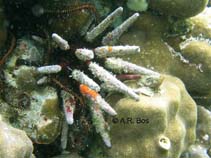Phyllacanthus imperialis Lamarck, 1816
Lance urchin| Native range | All suitable habitat | Point map | Year 2050 |

|
| This map was computer-generated and has not yet been reviewed. |
| Phyllacanthus imperialis AquaMaps Data sources: GBIF OBIS |
Classification / Names Common names | Synonyms | CoL | ITIS | WoRMS
Echinoidea | Cidaroida | Cidaridae
Environment: milieu / climate zone / depth range / distribution range Ecology
Reef-associated; depth range 0 - 15 m (Ref. 800). Tropical
Distribution Countries | FAO areas | Ecosystems | Occurrences | Introductions
Indo-West Pacific: East Africa and the Red Sea to Australia and Japan.
Length at first maturity / Size / Weight / Age
Maturity: Lm ? range ? - ? cm Max length : 7.0 cm WD male/unsexed; (Ref. 800)
Maximum primary spine length: 8.0 cm. Inhabits shallow reef areas at depths of 0 to 15 m. Hides in holes or under corals at day time (Ref. 800); and burrows in coral rock (Refs. 81254, 129602). Feeds on algae and small invertebrates (Ref. 800). Associated with coral communities. Nocturnal. Feeds on encrusting organisms (Ref. 129602).
Life cycle and mating behavior Maturity | Reproduction | Spawning | Eggs | Fecundity | Larvae
Members of the class Echinoidea are gonochoric. Fertilization is external. Brooding is common, eggs are held either on the peristome, around the periproct or deep into the concavities on the petaloids. Life cycle: Embryos develop into planktotrophic larvae (echinoplateus) and live for several months before they sink to the bottom using their tube feet to adhere on the ground where they metamorphose into young urchins.
Main reference
References | Coordinator | Collaborators
Schoppe, S. 2000. (Ref. 800)
IUCN Red List Status (Ref. 130435)
CITES status (Ref. 108899)
Not Evaluated
CMS (Ref. 116361)
Not Evaluated
Threat to humans
Harmless
Human uses
| FishSource |
Tools
More information
Internet sources
BHL | BOLD Systems | CISTI | DiscoverLife | FAO(Publication : search) | Fishipedia | GenBank (genome, nucleotide) | GloBI | Gomexsi | Google Books | Google Scholar | Google | PubMed | Tree of Life | Wikipedia (Go, Search) | Zoological Record
Estimates based on models
Preferred temperature
(Ref. 115969): 22.6 - 29.3, mean 28.2 (based on 2492 cells).
Price category
(Ref. 80766):
Unknown.



